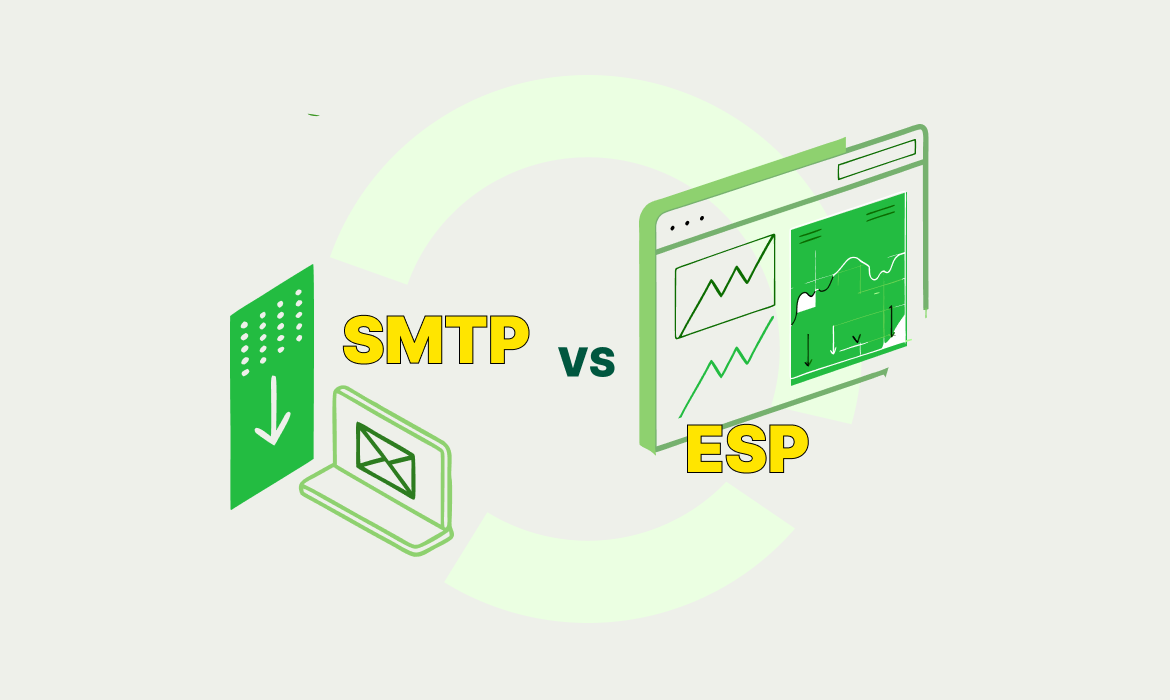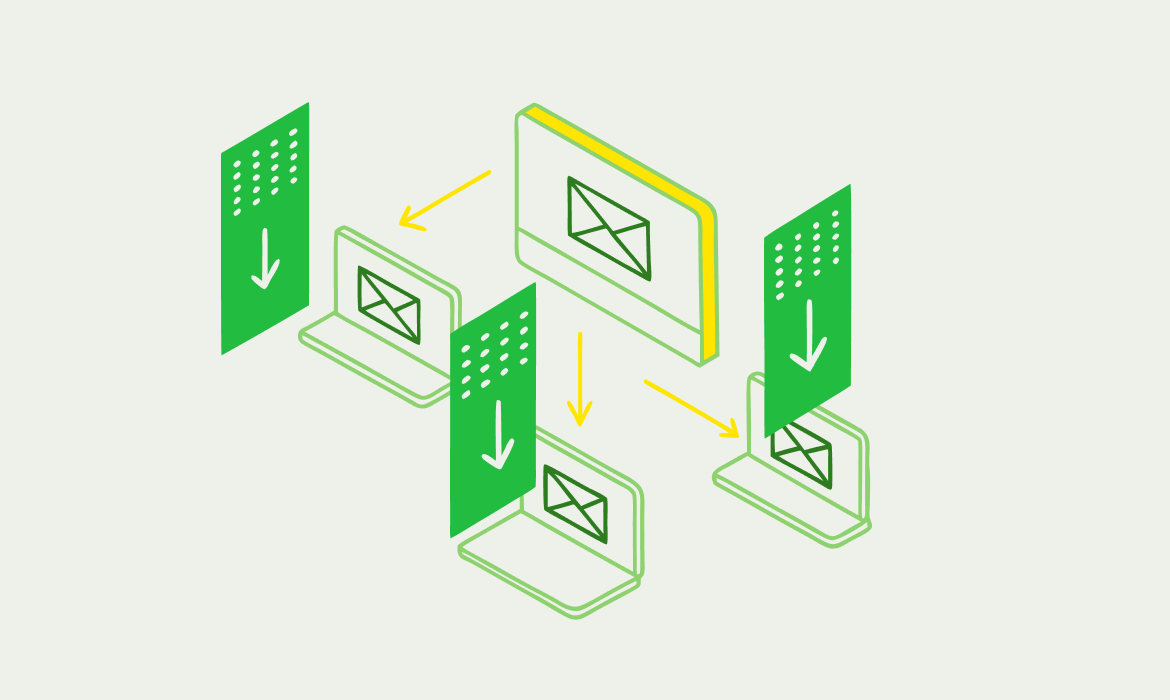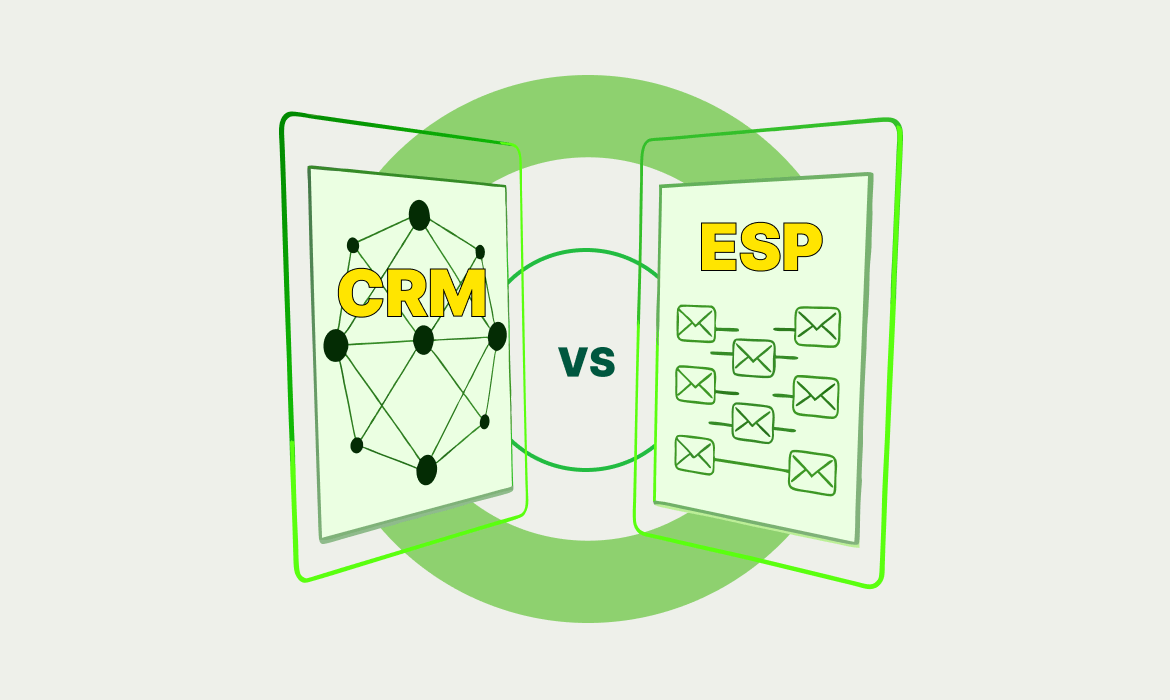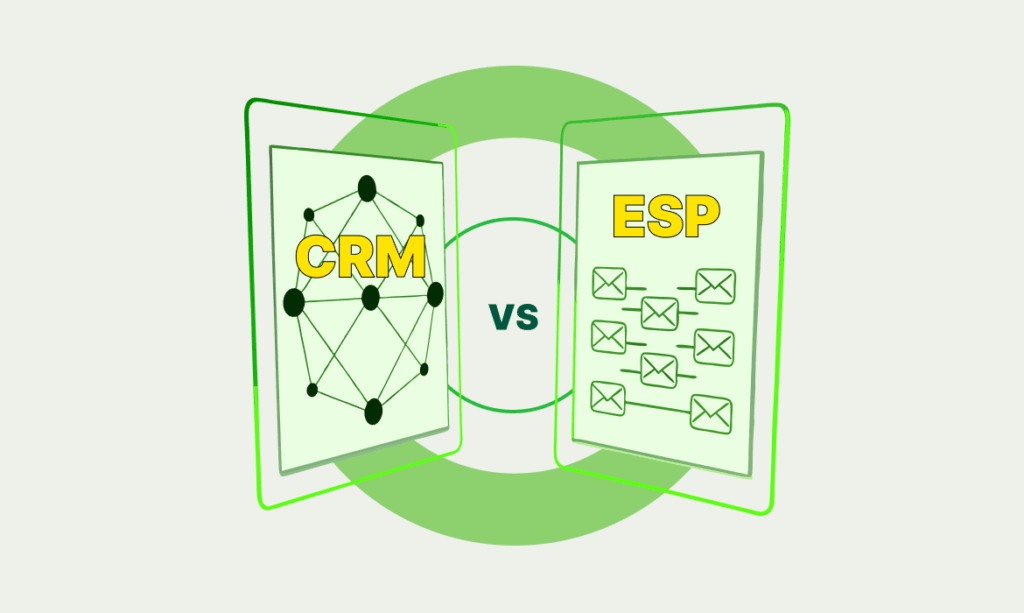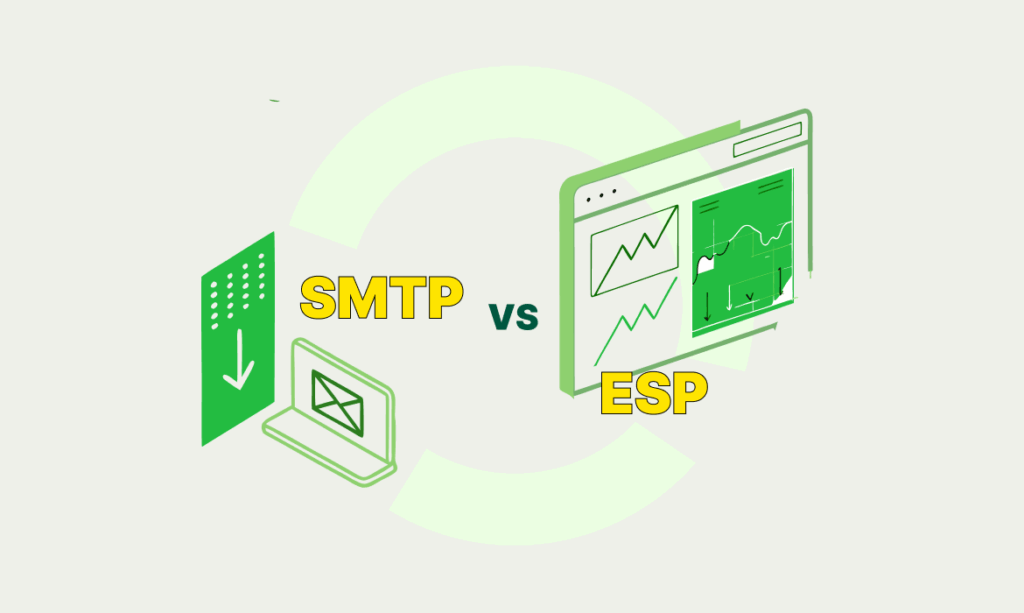
SMTP relay vs email service provider decisions can make or break your email communication strategy. In fact, email remains the number one channel consumers use to maintain contact with brands, particularly through mobile devices.
When managing business emails at scale, choosing between an email service provider (ESP) and an SMTP relay service becomes crucial. An ESP functions as a digital post office that helps businesses send emails to many people simultaneously while offering features like templates, contact management, and analytics. Meanwhile, SMTP relay services focus on ensuring high deliverability for bulk emails without getting flagged as spam. Both solutions serve different purposes – ESPs excel at marketing campaigns, while SMTP relay services typically handle transactional emails.
We’ll explore how these technologies work behind the scenes, when to use each one, and how to make the right choice for your business needs in 2025. As companies now spend less time on operations and more on strategy due to advancements in email technology, understanding these differences has never been more important for your business communication.
SMTP Relay vs Email Service Provider: Key Definitions Explained
Understanding the fundamental differences between SMTP relay services and email service providers forms the foundation for making intelligent email marketing decisions. Both tools serve critical but distinct roles in the email ecosystem.
What is an Email Service Provider (ESP)?
An email service provider (ESP) is a comprehensive platform that enables businesses to send marketing emails to a list of subscribers who have opted in to receive communications. ESPs store email addresses and handle the delivery of your campaigns, but their functionality extends far beyond simple sending.
Modern ESPs offer numerous capabilities that enhance email marketing efforts:
- Email and marketing automation workflows
- Lead capture forms for building subscriber lists
- A/B testing for optimizing content and subject lines
- Advanced audience segmentation
- Email engagement tracking and analytics
- Template libraries and content management tools
Essentially, an ESP functions as a complete email marketing solution that handles everything from list building to performance analysis. Pricing for ESP services typically reflects this broader feature set, with costs potentially reaching around $300 for sending 100,000 monthly emails.
What is an SMTP Relay Service?
SMTP (Simple Mail Transfer Protocol) relay is the process of transferring email from one server to another for delivery. An SMTP relay service is a third-party application that routes your outgoing emails through their servers to ensure reliable delivery.
When you use an SMTP relay provider, your outgoing messages are carried to an SMTP relay server managed by the provider before being delivered to recipients’ mailbox providers. This arrangement is particularly valuable for sending:
- Transactional emails (password resets, order confirmations)
- High-volume email campaigns
- Messages between different domains
SMTP relay services handle critical behind-the-scenes work including managing sender reputation, implementing authentication protocols (SPF, DKIM, DMARC), and processing bounces. These services typically cost significantly less than full-featured ESPs—often under $20 for 100,000 monthly emails.
ESP Email vs SMTP Relay: Core Purpose
The smtp relay vs email service provider distinction comes down to their fundamental purposes. ESPs are primarily designed for marketing communications, offering user-friendly interfaces that make it easy for non-technical people to create, send, and analyze email campaigns.
Conversely, SMTP relay services focus on reliable email delivery infrastructure. They excel at:
- Ensuring transactional and notification emails reach recipients
- Handling large volumes of outgoing mail efficiently
- Maintaining good deliverability without damaging your domain reputation
- Providing the technical backbone for email delivery
Many organizations actually employ both solutions simultaneously—using an ESP for marketing campaigns and an SMTP relay for transactional messages. This hybrid approach allows businesses to leverage the strengths of each platform based on specific email needs.
Additionally, SMTP relay services require more technical expertise to configure and manage compared to ESPs, which offer more intuitive interfaces designed for marketers without deep technical knowledge.
How They Work: Behind the Scenes of Email Delivery
The technical machinery powering email delivery differs substantially between SMTP relay services and email service providers (ESPs), despite both using SMTP protocol at their core. Let’s uncover what happens behind the curtain when you click “send.”
Email Sending Workflow: ESP vs SMTP Relay
The smtp relay vs email service provider workflow reveals fundamental differences in how messages reach their destination. With an ESP, the journey begins when you create an email in their platform:
- You design your email using the ESP’s interface and templates
- The ESP processes your message, adding tracking codes and formatting
- The ESP routes your email through their SMTP servers
- Their servers communicate with recipient mail servers
- Recipients’ email clients display your message
For SMTP relay services, the process follows a more direct path:
- You create your email in your own application or system
- Your application connects to the SMTP relay server
- The relay server authenticates your request
- The relay forwards your email to recipient mail servers
- Recipients’ email clients display your message
Furthermore, ESPs manage your contact lists, handle subscriber opt-outs, and track engagement, whereas SMTP relay services primarily focus on the delivery infrastructure itself.
SMTP Relay vs SMTP Server: Technical Differences
Many confuse SMTP relay services with standard SMTP servers, yet they serve different purposes. An SMTP server is a computer application responsible for sending, receiving, and routing emails using the Simple Mail Transfer Protocol. It’s the fundamental component of email infrastructure that handles outgoing messages.
Consequently, an SMTP relay service specializes in the process of transferring emails between different domains with enhanced delivery features. It acts as an intermediary that takes your outgoing messages and ensures they reach recipients’ servers reliably.
Key technical distinctions include:
- SMTP servers handle basic email routing within the same domain; relay services optimize cross-domain delivery
- SMTP servers struggle with large-scale operations; relay services are built for high-volume handling
- SMTP servers offer basic authentication; relay services implement advanced security protocols like SPF, DKIM, and DMARC
- SMTP servers provide limited deliverability tools; relay services maintain relationships with ISPs to maximize inbox placement
Initially, both use the same protocol, but relay services add specialized infrastructure and expertise focused on delivery success.
ESP Email Marketing Automation vs SMTP Transactional Focus
ESPs excel at marketing communications through robust automation capabilities. They transform from simple sending tools into comprehensive marketing assistants by enabling:
- Multi-step workflows triggered by subscriber actions
- Dynamic segmentation based on behavior and preferences
- A/B testing for subject lines, content, and automation sequences
- Personalized content customization using behavioral data
Subsequently, SMTP relay services primarily handle transactional and operational emails—those triggered by specific user actions or system events. They specialize in delivering password resets, order confirmations, shipping notifications, and account alerts.
SMTP relay services integrate directly with your application code or website backend through APIs or direct SMTP configuration. This allows developers to program exactly when and how transactional emails are triggered without needing marketing-focused interfaces.
Nevertheless, some organizations employ both solutions simultaneously—using an ESP for marketing campaigns and an SMTP relay for transactional messages—creating a hybrid approach that leverages the strengths of each platform.
Use Cases: When to Use SMTP Relay or an ESP
Choosing between SMTP relay vs email service provider solutions depends entirely on your specific communication needs. Each option serves distinct purposes in the email ecosystem.
Transactional Emails: Password Resets, Confirmations
SMTP relay services excel at delivering time-sensitive operational messages:
- Password resets – These critical security emails must reach users immediately. SMTP relay ensures these messages arrive within seconds, with some providers like Postmark guaranteeing 99% of emails delivered within 10 seconds.
- Order confirmations – Build brand credibility by sending purchase details promptly.
- Authentication emails – Keep users secure through reliable delivery of verification codes.
- Shipping notifications – Provide customers with timely updates on their purchases.
SMTP relay services are ideally suited for these transactional emails because they prioritize speed and deliverability over marketing features. Since these messages are triggered by specific user actions, they typically achieve higher open rates and engagement.
Third-party SMTP relay services especially make sense if:
- You need help improving deliverability
- Your applications can’t integrate with an API
- You’re sending moderate (not massive) email volumes
- You want something easier to set up and manage
Marketing Campaigns: Newsletters and Promotions
Email service providers (ESP email) are purpose-built for marketing communications:
- Customer onboarding – Create welcome sequences that introduce new subscribers to your brand.
- Content marketing – Share educational materials that build trust without direct sales pitches.
- Promotional offers – Deliver targeted discount codes and sale announcements.
- Retargeting campaigns – Re-engage users based on their browsing history.
ESPs offer specialized tools that SMTP relay services typically lack, accordingly enabling sophisticated marketing strategies. These platforms provide automation workflows, audience segmentation, A/B testing capabilities, and comprehensive analytics dashboards to measure campaign performance.
Most importantly, ESPs can handle complex campaign logic. For instance, someone signing up for your newsletter automatically receives a welcome series, or a customer abandoning their cart gets a reminder email with a discount.
Hybrid Use: Combining ESP and SMTP Relay
Many organizations benefit from employing both solutions simultaneously, creating a strategic balance:
- Cost optimization – Send high-volume transactional emails through cost-effective SMTP relay while using an ESP for more complex marketing communications.
- Deliverability protection – Keep your marketing and transactional email reputations separate to prevent issues with one affecting the other.
- Specialized functionality – Leverage marketing tools from ESPs alongside the reliability of SMTP relay for critical messages.
This dual approach allows businesses to segment their email traffic logically. For example, password reset emails should unquestionably be handled differently than weekly newsletters.
Furthermore, a multi-vendor strategy provides fallback options that increase reliability. If one provider experiences delivery issues, you can route critical communications through alternative channels.
Obviously, this approach creates additional complexity in your email infrastructure. However, for organizations with diverse email needs, the benefits of specialization typically outweigh the additional management overhead.
Performance, Deliverability, and Compliance
Beyond features and use cases, the smtp relay vs email service provider comparison extends to critical factors affecting email performance.
IP Warming and Sender Reputation
Successful email delivery hinges on proper IP warming—a process of gradually increasing email volume from a new IP address to build sender reputation. This matters because:
First, Internet Service Providers (ISPs) treat new IP addresses with suspicion. Sending high volumes immediately can trigger blocklisting, severely damaging deliverability. The warming process involves starting with small email volumes and methodically increasing over time.
Most SMTP relay services offer automated IP warming that throttles traffic according to a predefined schedule. For example, on day one, the limit might be just 20 emails per hour, gradually increasing to over 14 million by day 41. Moreover, transactional email senders enjoy more flexibility in warming schedules than marketing senders, who must adhere to stricter guidelines.
Email Authentication: SPF, DKIM, DMARC
Both ESPs and SMTP relays implement three critical authentication protocols to verify email legitimacy:
- SPF (Sender Policy Framework): Lists authorized servers that can send emails from your domain, functioning like an employee directory that confirms sender legitimacy
- DKIM (DomainKeys Identified Mail): Digitally signs emails using cryptographic keys, ensuring message integrity during transit
- DMARC (Domain-based Message Authentication Reporting and Conformance): Tells receiving servers what to do when SPF or DKIM checks fail
These protocols work together as interdependent building blocks—implementing anything less results in substandard protection. Even domains that don’t send emails should implement DMARC records to prevent spammers from impersonating them.
Data Privacy and Compliance: GDPR, CAN-SPAM
Email regulations vary globally but share common requirements:
Under CAN-SPAM, each violation can result in penalties up to $53,088 per email. Key requirements include accurate header information, honest subject lines, clear identification as advertisements, and valid physical addresses.
In contrast, GDPR focuses on explicit consent and data protection, with potential fines reaching €20 million or 4% of global annual turnover. Businesses must implement robust data security practices, enable easy access to personal data, and incorporate privacy by design.
A reliable email service—whether ESP or SMTP relay—helps maintain compliance with these regulations so you don’t have to monitor constantly changing rules. This becomes especially valuable for global businesses that must comply with laws in both sender and recipient countries.
Choosing the Right Solution for Your Business:
When evaluating smtp relay vs email service provider options, your final decision ultimately depends on specific business requirements. The right choice hinges on understanding your organizational needs and future growth plans.
Scalability and Email Volume Needs
Email volume significantly impacts which solution works best for your business. Generally, organizations fall into distinct categories based on sending patterns:
- Low volume senders (under 10,000 monthly emails) – Basic ESP features typically suffice
- Medium volume senders (10,000-100,000 monthly emails) – Either solution works, with choice depending on email type
- High volume senders (over 100,000 monthly emails) – SMTP relay services often provide better cost efficiency
As your business grows, scalability becomes increasingly important. SMTP relay services excel at handling massive volume spikes without performance degradation. First and foremost, consider whether your sending needs are steady or fluctuate dramatically—SMTP relay providers typically offer more flexible pricing models for variable volume.
Notably, transactional email volumes tend to correlate directly with user activity and business growth. As such, choosing a solution that scales effortlessly prevents future migration headaches when volume increases.
Integration with CRM, E-commerce, and APIs
The technical complexity of your existing infrastructure plays a crucial role in the selection process. Consider these integration factors:
- Developer resources – SMTP relay services require more technical expertise to implement but offer greater customization
- CRM compatibility – Many ESPs provide pre-built integrations with popular CRM platforms
- E-commerce needs – Order confirmations and shipping notifications demand reliable SMTP relay services with robust APIs
Indeed, ESPs typically offer more user-friendly interfaces with drag-and-drop capabilities, whereas SMTP relay services provide deeper API access for custom implementations. Furthermore, businesses using multiple systems (such as separate CRM, e-commerce, and customer service platforms) might benefit from an SMTP relay’s versatility in connecting these disparate systems.
Ideally, your chosen solution should align with your technical team’s capabilities. Organizations without dedicated developers often find ESPs more accessible, while companies with technical resources can leverage SMTP relay services’ advanced capabilities.
Conclusion:
Making the Right Decision for Your Email Strategy
Choosing between SMTP relay vs email service provider comes down to your specific communication goals. Both solutions offer distinct advantages depending on your email types and technical capabilities.
ESPs excel at marketing campaigns through user-friendly interfaces, comprehensive analytics, and automation features. These platforms help marketers without deep technical knowledge create engaging campaigns efficiently. Though priced higher, their all-in-one approach justifies the investment for marketing-focused teams.
SMTP relay services deliver exceptional results for transactional emails, offering superior deliverability at lower costs. Their technical focus makes them ideal for password resets, order confirmations, and other time-sensitive communications. Businesses with developer resources can leverage their flexibility and scalability advantages.
Many successful companies actually implement both solutions simultaneously. This hybrid approach maximizes strengths while minimizing weaknesses. Your marketing team uses an ESP for campaigns while your developers implement SMTP relay for transactional messages.
Before making your final decision, assess your email volume needs, technical capabilities, integration requirements, and budget constraints. The right choice will align with your specific business goals while ensuring your messages consistently reach their intended recipients. After all, effective email delivery remains essential for maintaining strong customer relationships regardless of which solution you select.
FAQs
- What is the main difference between SMTP relay vs email service provider?
SMTP relay focuses on reliable message delivery infrastructure, while an email service provider offers full marketing features like templates, list management, and analytics. - When should a business choose an SMTP relay over an email service provider?
Use SMTP relay for high-volume transactional emails such as password resets or order confirmations that demand instant, spam-free delivery. - When is an email service provider better than an SMTP relay?
Choose an ESP when you need drag-and-drop builders, automation workflows, segmentation, and performance reports for marketing campaigns. - Can I use both SMTP relay and an email service provider together?
Yes. Many companies send marketing emails through an ESP and route transactional messages through an SMTP relay to optimize cost and deliverability. - How does pricing differ for SMTP relay vs email service provider services?
SMTP relays often start under $20 for 100 k emails, while full ESP plans with automation can exceed $300 for the same volume because of added features. - What role does authentication play in SMTP relay vs email service provider setups?
Both should implement SPF, DKIM, and DMARC. SMTP relays typically require manual setup; ESPs usually guide you through DNS changes in their dashboards. - Which option offers better deliverability—SMTP relay or ESP?
Deliverability depends on IP reputation and list hygiene. SMTP relays excel at raw inbox placement, while ESPs add engagement tools that also improve reputation. - Do SMTP relays provide analytics like an email service provider?
Most SMTP relays offer basic delivery and bounce dashboards; ESPs supply deeper insights such as opens, clicks, heatmaps, and A/B test results. - Is technical knowledge required for SMTP relay vs email service provider integration?
SMTP relays need developer resources for API or SMTP setup. ESPs are designed for marketers and usually need little or no coding. - How do I migrate from an ESP to SMTP relay without hurting deliverability?
Warm up new IPs gradually, keep lists clean, authenticate the sending domain, and monitor bounce and complaint rates during the transition.

